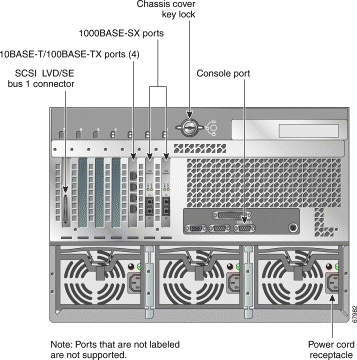|
|

You have just purchased a Cisco Content Distribution Manager 4650 (CDM-4650) with one of the following software releases installed:
The Cisco Content Distribution Manager is the content distribution and management element of a larger, Cisco Content Delivery Network (CDN) solution, which includes content routing, content switching, content delivery, and content services, as well as content distribution and management.
The CDM-4650 should be located at the logical central point of your WAN to give you complete control over your entire media distribution network. It operates in conjunction with Cisco Content Engines (located at your end user sites) that receive and transmit streaming media to audiences over the LAN.
The CDM-4650 uses a powerful yet simple web browser-based user interface that allows you to configure and monitor Cisco Content Engines anywhere in the world, import and preview any rich media—including TV-quality video—and generate media URLs for your internal and external websites. You can also set maximum bandwidth usage rates for distributing media to Cisco Content Engines over the WAN, as well as from Content Engines to end users over the LAN to ensure that you never congest the network.
 |
Note For information on using the DLT 7000 tape drive to back up data when upgrading from a SightPath Studio device to the Cisco CDM-4650, refer to the SightPath to Cisco Hardware Migration Procedure document. For information on general backup and restore procedures, refer to Chapter 4 of the Cisco Enterprise CDN Software User Guide Version 3.0, or to the ACNS software documentation. |
 |
Note For information on setting up the CDM-4650 RAID configuration for the Cisco Storage Array with Enterprise CDN software, refer to the Release Notes for Cisco Enterprise CDN Software Version 3.0.2 document. |
For network connections, the CDM-4650 has one onboard 10BASE-T/100BASE-TX Ethernet/
Fast Ethernet port and a four-port 10BASE-T/100BASE-TX Ethernet/Fast Ethernet network interface card with autodetect speed mode and full-duplex operation. In E-CDN software releases prior to ACNS 4.0, the onboard port is the only Ethernet interface that is recognized. However, in ACNS 4.0 and later ACNS software releases, the ports on the four-port Ethernet card are the only interfaces that are recognized; the single onboard port is ignored.
Although ACNS software recognizes all four of the ports on the four-port Ethernet card, the ACNS E-CDN application only uses one of those ports. The primary interface configuration designates which of these ports is used by the ACNS E-CDN application.
Table 1 lists the storage, memory, and CPU specifications for the CDM-4650.
| Specification | Description |
|---|---|
Internal hard disk storage | 8 18-GB Ultra2 LVD SCSI hard drives |
External hard disk storage | SA-12 |
Memory | 1-GB SDRAM |
1-GHz Xeon |
The CDM-4650 has the following major hardware features:
The CDM-4650 manages up to 1000 Content Engines and has the following software features:
The Enterprise CDN software does not support the PowerEdge Expandable Redundant Array of Inexpensive Disks Controller 3 Small Computer System Interface card (PERC3 SCSI card). Therefore, a CDM-4650 operating with ACNS software and a PERC3 SCSI card cannot be downgraded to Enterprise CDN software. A CDM-4650 operating with Enterprise CDN software and a PERC2 card can be upgraded to ACNS software. Recently manufactured CDM-4650 units are shipped with the PERC3 rather than the PERC2 card. For either card, the SCSI bus 1 interface is active and the SCSI bus 0 interface is factory-sealed. A PERC3 card has two connectors mounted one above the other; SCSI bus 1 is the lower connector, as shown in Figure 1. A PERC2 card has two SCSI bus connectors mounted side by side; SCSI bus 1 is the left connector.

CCIP, the Cisco Powered Network mark, the Cisco Systems Verified logo, Cisco Unity, Fast Step, Follow Me Browsing, FormShare, Internet Quotient, iQ Breakthrough, iQ Expertise, iQ FastTrack, the iQ Logo, iQ Net Readiness Scorecard, Networking Academy, ScriptShare, SMARTnet, TransPath, and Voice LAN are trademarks of Cisco Systems, Inc.; Changing the Way We Work, Live, Play, and Learn, Discover All That's Possible, The Fastest Way to Increase Your Internet Quotient, and iQuick Study are service marks of Cisco Systems, Inc.; and Aironet, ASIST, BPX, Catalyst, CCDA, CCDP, CCIE, CCNA, CCNP, Cisco, the Cisco Certified Internetwork Expert logo, Cisco IOS, the Cisco IOS logo, Cisco Press, Cisco Systems, Cisco Systems Capital, the Cisco Systems logo, Empowering the Internet Generation, Enterprise/Solver, EtherChannel, EtherSwitch, GigaStack, IOS, IP/TV, LightStream, MGX, MICA, the Networkers logo, Network Registrar, Packet, PIX, Post-Routing, Pre-Routing, RateMUX, Registrar, SlideCast, StrataView Plus, Stratm, SwitchProbe, TeleRouter, and VCO are registered trademarks of Cisco Systems, Inc. and/or its affiliates in the U.S. and certain other countries.
All other trademarks mentioned in this document or Web site are the property of their respective owners. The use of the word partner does not imply a partnership relationship between Cisco and any other company. (0201R)
![]()
![]()
![]()
![]()
![]()
![]()
![]()
![]()
Posted: Wed Nov 6 10:19:49 PST 2002
All contents are Copyright © 1992--2002 Cisco Systems, Inc. All rights reserved.
Important Notices and Privacy Statement.